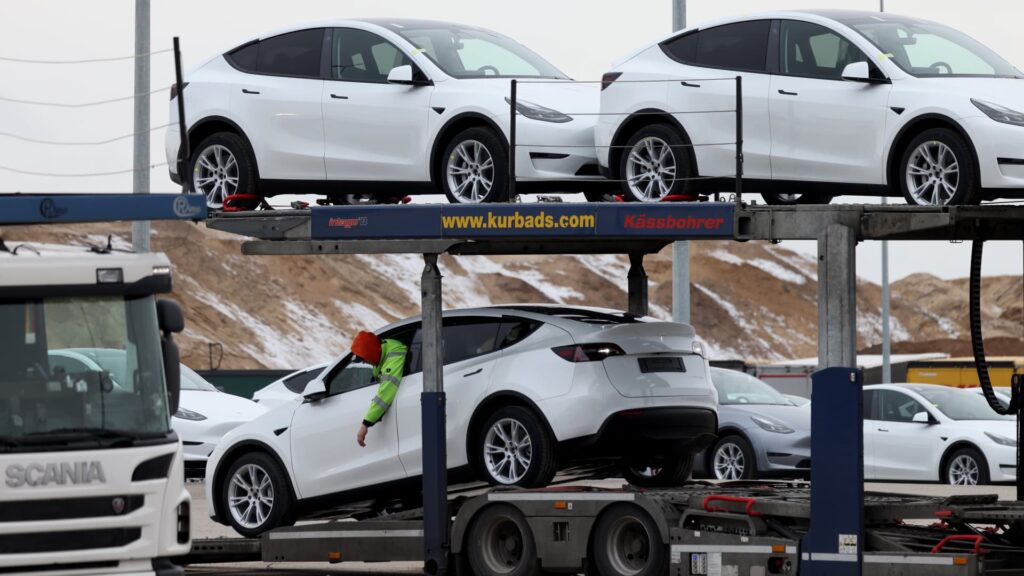tesla released its fourth quarter vehicle production and delivery report on Thursday. The important numbers are:
Total deliveries in Q4 2024: 495,570
Total production in Q4 2024: 459,445 units
Total annual deliveries in 2024: 1,789,226
Total annual production in 2024: 1,773,443
The quarter’s results marked Tesla’s first decline in deliveries in a year, with the company reporting 1.81 million deliveries in 2023. Deliveries in the fourth quarter of 2023 were reported to be 484,507 units.
Tesla shares fell as much as 7% in trading on Thursday, but rebounded on Friday.
Analysts had expected Tesla to report deliveries of 504,770 vehicles in the quarter, including 474,000 Model 3 and Model Y EVs, according to consensus estimates compiled by Street Account. Tesla sent some investors its consensus of 506,763 deliveries based on a survey of 26 analysts. A widely followed independent Tesla researcher who publishes as Troy Teslike predicted shipments to be 501,000 units.
Deliveries are the closest thing to Tesla’s reported sales, but they are not precisely defined in the company’s shareholder communications.
The fourth quarter report comes on the heels of a strong rally in Tesla stock, which ended 2024 with a 63% gain at the end of the year. In mid-December, the stock reached an all-time high, surpassing its highest since 2021.
That’s a big turnaround from the worst first quarter since 2022, when the company’s stock price plunged 29% as it battled declining sales despite price cuts and buyer incentives. Chief Executive Officer Elon Musk told investors at the first quarter results conference in April that he expected “sales this year to exceed last year,” but that the growth rate would rise from 38% in 2023. He said it would slow down.
The biggest story at Tesla in the second half of this year was Musk’s role in President-elect Donald Trump’s campaign. Mr. Musk, the world’s richest man, spent several weeks campaigning in battleground states, spending about $277 million promoting Mr. Trump and other Republican candidates.
Elon Musk speaks with U.S. President-elect Donald Trump during a viewing of the launch of the SpaceX Starship rocket’s sixth test flight in Brownsville, Texas, U.S., November 19, 2024.
Brandon Bell | via Reuters
Musk, who runs SpaceX and xAI and also owns social network
Sam Fiorani, vice president of industry research group Autoforecast Solutions, told CNBC in an email that Musk’s foray into politics may have “taken focus away from the core business.” But how much investors and EV buyers care won’t be reflected in Tesla’s numbers until the first quarter, he said.
Until recently, Tesla was one of the only automakers to mass produce battery electric vehicles. The company currently faces intense competition from domestic automakers including: general motors, ford and Rivian So are China’s BYD, South Korea’s Hyundai, and European car giants. BMW and volkswagen.
Patrick George, editor-in-chief of InsideEVs, told CNBC that he believes Tesla is better than other EV manufacturers in many ways, especially when it comes to charging networks. However, Tesla’s biggest management challenge in the latest quarter was its “fundamental work as a car company.”
“It’s piled up in a used car lot.”
Tesla is investing in humanoid robotics efforts and chip development, and plans to produce its own robotaxis and launch driverless ride-hailing services by 2027. While Musk and shareholders may not want to see Tesla as just another car company, most of its profits still come from vehicle sales.
George said Tesla made a mistake by not introducing a “more affordable EV in 2024,” and that the company’s newest vehicle, the Cybertruck, is “piling up in used car lots.” he added. The angular steel Cybertruck costs about $80,000.
As competitors expand their market share in Europe, Tesla saw a significant decline in sales in the region in the fourth quarter.
A new Tesla Model Y electric vehicle is loaded onto a car carrier at the Tesla Gigafactory Berlin-Brandenburg site.
Patrick Prull | Picture Alliance | Getty Images
Tesla sold 283,000 cars in Europe from January to the end of November, down about 14% from a year earlier, according to registration data from the European Automobile Manufacturers Association (ACEA). The number of registrations in Europe in November fell to 18,786 from around 31,810 a year earlier.
The company’s China business also came under pressure in the fourth quarter.
Fiorani said the Model Y is China’s second-best-selling model, but “its growth has not kept pace with market growth.” Through November, Model Y sales were up more than 5%, while overall domestic EV sales were up 8%, he said.
Meanwhile, BYD and other Chinese brands such as Chery, Li Auto, Jet Tour, Leap Motor, and Aito grew significantly faster than Tesla. BYD has also established factories outside of China and exports a large amount of its products.
In North America, Tesla continues to dominate. In the fourth quarter, the company offered a variety of incentives and discounts on its most popular SUV, the Model Y, to boost sales. Still, Tesla experienced inventory buildup.
During the fourth quarter, the company sent Cybertruck assembly line workers home for several days, suggesting it may be trying to avoid flooding the market with too many vehicles.
Looking ahead to 2025, Musk said in an October earnings call that he expects Tesla to offer low-cost self-driving cars in 2025, leading to “20% to 30% growth” compared to 2024. said.
Attention: China’s car market could reach 55-60% EV share by the end of 2025



